Chinese emperors family tree (late)
This is a family tree of Chinese emperors from the Mongol conquest of 1279 to end of the Qing dynasty in 1912.
Chinese emperors family tree (ancient) → Chinese emperors family tree (early) → Chinese emperors family tree (middle) → Chinese emperors family tree (late)
Yuan dynasty and Northern Yuan dynasty
The following is the Yuan dynasty family tree. Genghis Khan founded the Mongol Empire in 1206. The empire became split beginning with the succession war of his grandsons Kublai Khan and Ariq Boke. Kublai Khan, after defeating his younger brother Ariq Boke, founded the Yuan dynasty in China in 1271. The dynasty was overthrown by the Ming dynasty during the reign of Toghun Temür in 1368, but it survived in Mongolia, known as the Northern Yuan dynasty; years of reign over the Northern Yuan dynasty (up to 1388) are given in brackets.
Yesükhei Baghatur | |||||||||||||||||||||||||||||||||||||||||||||||||||||||
| 1 | 2 | 3 (1) | 4 (2) | 5 (3) | 6 (4) | ||||||||||||||||||||||||||||||||||||||||||||||||||
| Belgutei | Bekhter | Temujin Genghis Khan ~1162–1227 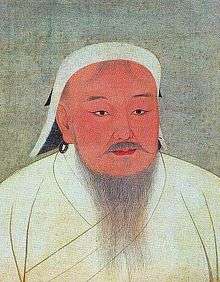 Taizu 太祖 Khagan 1206–1227 | Hasar | Hachiun | Temüge 1168–1246 | ||||||||||||||||||||||||||||||||||||||||||||||||||
| 1 | 2 | 3 | 4 | ||||||||||||||||||||||||||||||||||||||||||||||||||||
| Jochi c.1181–1227 | Chagatai 1183–1242 | Ögedei Khan ~1186–1241 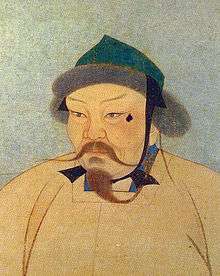 Taizong 太宗 Khagan 1229–1241 | Töregene Great Khatun 1242–1246 | Tolui ~1190–1232 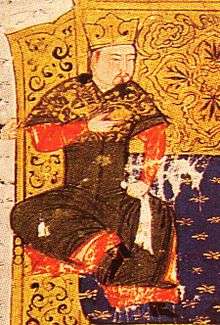 Ruizong 睿宗 (Khagan 1227–1229) | |||||||||||||||||||||||||||||||||||||||||||||||||||
| 1 | 1 | 2 | 3 | 4 | |||||||||||||||||||||||||||||||||||||||||||||||||||
| Oghul Qaimish d. 1251 Khagan 1248–1251 | Güyük Khan ~1206–1248 Dingzong 定宗 Khagan 1246–1248 | Möngke Khan ~1208–1259 Xianzong 憲宗 Khagan 1251–1259 | Kublai Khan 1215–1294  Khagan 1260–1271 Shizu 世祖 1271–1294 | Hulagu ~1217–1265 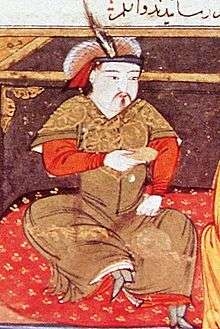 Ilkhan 1256–1265 | Ariq Böke d. 1266 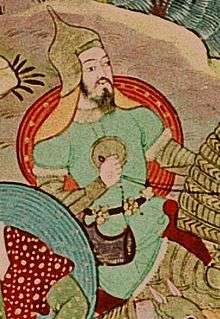 Khagan 1260? | ||||||||||||||||||||||||||||||||||||||||||||||||||
| 2 | |||||||||||||||||||||||||||||||||||||||||||||||||||||||
| Zhenjin 真金 1243–1286 Yuzong 裕宗 | |||||||||||||||||||||||||||||||||||||||||||||||||||||||
| 1 | 2 | 3 | |||||||||||||||||||||||||||||||||||||||||||||||||||||
| Gammala 1263-1302 Xianzong 顯宗 | Darmabala d. 1292 Shunzong 順宗 | Temür Öljeytü Khan 1265–1307  Chengzong 成宗 1294–1307 | |||||||||||||||||||||||||||||||||||||||||||||||||||||
| 1 | 1 | 2 | |||||||||||||||||||||||||||||||||||||||||||||||||||||
| Yesün Temür Khan 1293–1328 Taiding 泰定 1323–1328 | Kayishan Külüg Khan 1281–1311 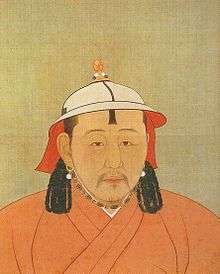 Wuzong 武宗 1307–1311 | Ayurbarwada Buyantu Khan 1286–1320  Renzong 仁宗 1311–1320 | |||||||||||||||||||||||||||||||||||||||||||||||||||||
| 1 | 1 | 2 | 1 | ||||||||||||||||||||||||||||||||||||||||||||||||||||
| Ragibagh Khan ~1320–1328? Tianshun 天順 1328 | Kuśala Khutughtu Khan 1300–1329 Mingzong 明宗 1329 | Tugh Temür Jayaatu Khan 1304–1332 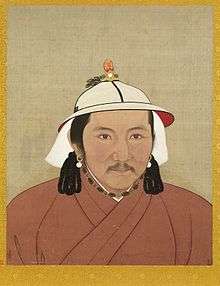 Wenzong 文宗 1328–1329 1329–1332 | Shidibala Gegeen Khan 1303–1323 Yingzong 英宗 1321–1323 | ||||||||||||||||||||||||||||||||||||||||||||||||||||
| 1 | 2 | ||||||||||||||||||||||||||||||||||||||||||||||||||||||
| Toghun Temür Ukhaantu Khan 1320–1370 Huizong 惠宗 1333–68 (–1370) | Rinchinbal Khan 1326–1332 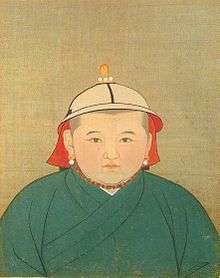 Ningzong 寧宗 1332 | ||||||||||||||||||||||||||||||||||||||||||||||||||||||
| Northern Yuan dynasty | |||||||||||||||||||||||||||||||||||||||||||||||||||||||
| Ayushiridara Biligtü Khan Zhaozong 昭宗 1370–1378 | Tögüs Temür Uskhal Khan Yizong 益宗 1378–1388 | uncertain lineage/ancestry | |||||||||||||||||||||||||||||||||||||||||||||||||||||
| Yesüder Jorightu Khan 1358–1388–1392 | Elbeg Nigülesügchi Khan 1361-1393-1399 | Örüg Temür Khan 1402–1408 | Oyiradai ?-1415–1425 | ||||||||||||||||||||||||||||||||||||||||||||||||||||
| (?) Engke Khan ?–1392 | Gün Temür 1377-1400-1402 | Kharghochok 哈尔古楚克都古楞 特穆尔鸿台吉 1363-1399 | Öljei Temür Bunyashir Khan 1379-1408–1412 | Adai Khan 1390–1425–1438 | |||||||||||||||||||||||||||||||||||||||||||||||||||
| Ajai 阿齋 1399-1438 | Delbeg Khan 1395-1412–1415 | ||||||||||||||||||||||||||||||||||||||||||||||||||||||
| Toghtoa Bukha Taisun Khan 1413-1433–1453 | Obogh Manduulun Manduul Khan 1438–1475-1478 | Agbarjin 1454 | |||||||||||||||||||||||||||||||||||||||||||||||||||||
| Markörgis Khan 1448–1455–1465 | Molon Khan ?-1465–1466 | Kharghochok ?-1453 | |||||||||||||||||||||||||||||||||||||||||||||||||||||
| Bayan Mongke 1453-1479 | |||||||||||||||||||||||||||||||||||||||||||||||||||||||
| Batumöngke Dayan Khan 1464–1479– 1517/1543 | |||||||||||||||||||||||||||||||||||||||||||||||||||||||
| Turbolad 1482-before1517 | Bars Bolud Jinong Barsbolad Khan 1490–1516–1519 | ||||||||||||||||||||||||||||||||||||||||||||||||||||||
| Bodi Alagh 1504–1519–1547 | Anda Altan Khan 1507–1582 | ||||||||||||||||||||||||||||||||||||||||||||||||||||||
| Daraisung Guden 1520–1547–1557 | Sengge Düüreng ?-1582—1586 | ||||||||||||||||||||||||||||||||||||||||||||||||||||||
| Tümen Zasagt 1539-1558–1592 | Namudai Sechen 1586 — 1607 | ||||||||||||||||||||||||||||||||||||||||||||||||||||||
| Buyan Sechen 1554–1556–1604 | Boshugtu 1613—1627 | ||||||||||||||||||||||||||||||||||||||||||||||||||||||
| Mangghus | Emùbù 1627—1634 | ||||||||||||||||||||||||||||||||||||||||||||||||||||||
| Ligdan Khutugtu 1588–1603–1634 | |||||||||||||||||||||||||||||||||||||||||||||||||||||||
| Ejei Khongghor ?–1634– 1635-1661 | |||||||||||||||||||||||||||||||||||||||||||||||||||||||
Ming dynasty and Southern Ming
The following is a simplified family tree for the Ming dynasty, which ruled China between 1368 and 1644.
Those who became emperor are listed in bold, with their years of reign. In China, Ming emperors are best known by their temple names, which are given second below, after the personal name. (The Jianwen Emperor was not awarded a temple name: his posthumous name, Huidi (惠帝), is used instead.) The names given in bold are era names, the form by which Ming emperors are most commonly known in English, but which technically refer to the timespan of an emperor's reign rather than to the emperor himself. (Xingzong and Ruizong are temple names: they never actually ruled, but Xingzong was posthumously granted an emperor's title and Ruizong was raised posthumously to the status of emperor by his son, the Jiajing Emperor, in the Great Rites Controversy.) The imperial family's original family name was Zhu (朱), but the Hongwu Emperor opted for the dynastic name Ming (明), meaning "brilliant". After the fall of the dynasty in 1644 and the Chongzhen Emperor's suicide, a series of Ming princes based in the south of China claimed the imperial title, their court being known as the Southern Ming dynasty. These claimants are given with their era names, and the timespans of their purported reigns in brackets. Their purported periods of rule are given in brackets. In 1662, Koxinga regained control of Taiwan from the Dutch colonial regime, and established a state for those who wished restore the Ming dynasty to power. This state lasted until 1683, when it submitted to the Qing dynasty. Legend:
- - Ming dynasty emperors
- - Southern Ming emperors
| Zhu Yuanzhang 朱元璋 1328–1398 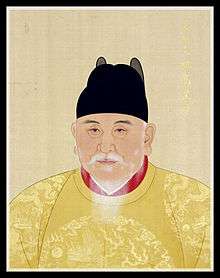 Taizu 太祖 Hongwu 洪武 1368–1398 | |||||||||||||||||||||||||||||||||||||||||||||||||||||||||||||
| 1 | 4 | 10 | 17 | 23 | |||||||||||||||||||||||||||||||||||||||||||||||||||||||||
| Zhu Biao 朱標 1355–1392 Xingzong 興宗 | Zhu Di 朱棣 1360–1424 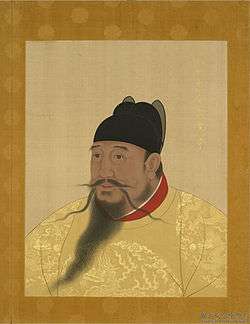 Chengzu成祖 Yongle 永樂 1402–1424 | Zhu Tan 朱檀 1370-1389 Prince Huang of Lu 魯荒王 | Zhu Quan 朱權 1378–1448 Prince of Ning 寧王 | Zhu Jing 朱桱 1388–1415 Prince Ding of Tang 唐定王 | |||||||||||||||||||||||||||||||||||||||||||||||||||||||||
| 2 | 1 | 1 | |||||||||||||||||||||||||||||||||||||||||||||||||||||||||||
| Zhu Yunwen 朱允炆 1377–1402? 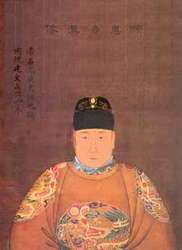 Huidi 惠帝 Jianwen 建文 1398–1402 | Zhu Gaochi 朱高熾 1378–1425  Renzong 仁宗 Hongxi 洪熙 1424–1425 | Zhu Zhaohui 朱肇煇 1388-1466 Prince Jing of Lu | Zhu Qiongda 朱瓊炟 d. 1475 Prince Xian of Tang 唐憲王 | ||||||||||||||||||||||||||||||||||||||||||||||||||||||||||
| 1 | 1 | 7 | 1 | ||||||||||||||||||||||||||||||||||||||||||||||||||||||||||
| Zhu Wenkui 朱文奎 1396-? | Zhu Zhanji 朱瞻基 1399–1435  Xuanzong 宣宗 Xuande 宣德 1425–1435 | Zhu Zhanyu 朱瞻墺 1409—1446 Prince Jing of Huai 淮靖王 | Zhu Taikan 朱泰堪 1412-1473 Prince Hui of Lu 魯惠王 | Zhu Zhizhi 朱芝址 d. 1485 Prince Zhuang of Tang 唐莊王 | |||||||||||||||||||||||||||||||||||||||||||||||||||||||||
| 1 | 2 | 1 | |||||||||||||||||||||||||||||||||||||||||||||||||||||||||||
| Zhu Qizhen 朱祁鎮 1427–1464 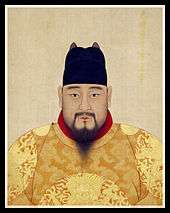 Yingzong 英宗 Zhengtong 正統 1435–1449 Tianshun 天順 1457–1464 | Zhu Qiyu 朱祁鈺 1428–1457  Daizong 代宗 Jingtai 景泰 1449–1457 | Zhu Qiquan 朱祁銓 1435-1502 Prince Kang of Huai 淮康王 | Zhu Yangzhu 朱陽鑄 1448-1523 Prince Zhuāng of Lu 魯莊王 | Zhu Miqian 朱彌鉗 Prince Gong of Tang 唐恭王 | |||||||||||||||||||||||||||||||||||||||||||||||||||||||||
| 1 | 1 | ||||||||||||||||||||||||||||||||||||||||||||||||||||||||||||
| Zhu Jianshen 朱見深 1447–1487 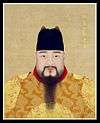 Xianzong 憲宗 Chenghua 成化 1464–1487 | Zhu Jiandian 朱見澱 ?-1502 Prince Duan of Huai 淮端王 | Zhu Dangcong 朱當漎 1473-1505 Prince Huai of Lu 魯懷王 | Zhu Yuwen 朱宇溫 d. 1560 Prince Jing of Tang 唐敬王 | ||||||||||||||||||||||||||||||||||||||||||||||||||||||||||
| 3 | 4 | 1 | |||||||||||||||||||||||||||||||||||||||||||||||||||||||||||
| Zhu Youtang 朱祐樘 1470–1505 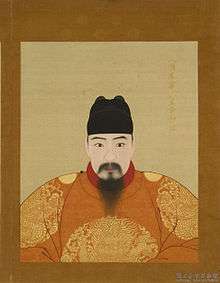 Xiaozong 孝宗 Hongzhi 弘治 1487–1505 | Zhu Youyuan 朱祐杬 1476–1519 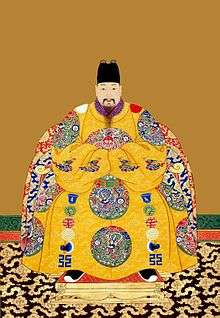 Ruizong 睿宗 | Zhu Youkui 朱祐楑 1500-1537 Prince Zhuang of Huai 淮莊王 | Zhu Jianyi 朱健杙 1494-1520 Prince Dao of Lu 魯悼王 | Zhu Zhouyong 朱宙栐 d.1564 Prince Shun of Tang 唐順王 | |||||||||||||||||||||||||||||||||||||||||||||||||||||||||
| 1 | 2 | 1 | |||||||||||||||||||||||||||||||||||||||||||||||||||||||||||
| Zhu Houzhao 朱厚照 1491–1521 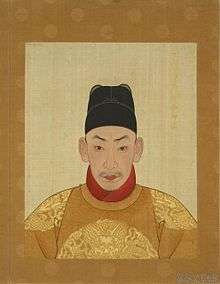 Wuzong 武宗 Zhengde 正德 1505–1521 | Zhu Houcong 朱厚熜 1507–1567 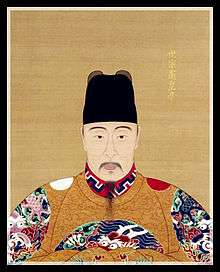 Shizong 世宗 Jiajing 嘉靖 1521–1567 | Zhu Houchou 朱厚燽 1519-1563 Prince Xian of Huai 淮宪王 | 朱觀𤊟 1520-1549 Prince Duan of Lu 魯端王 | Zhu Shuohuang 朱碩熿 d. 1632 Prince Duan of Tang 唐端王 | |||||||||||||||||||||||||||||||||||||||||||||||||||||||||
| 3 | 1 | ||||||||||||||||||||||||||||||||||||||||||||||||||||||||||||
| Zhu Zaihou 朱載垕 1537–1572 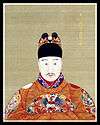 Muzong 穆宗 Longqing 隆慶 1567–1572 | Zhu Zaijian 朱载坚 ?-1595 Prince Shun of Huai 淮顺王 | Zhu Yitan 朱頤坦 ?-1594 Prince Gong of Lu 魯恭王 | Zhu Qisheng 朱器墭 Prince Yu of Tang 唐裕王 | ||||||||||||||||||||||||||||||||||||||||||||||||||||||||||
| 3 | 4 | 9 | |||||||||||||||||||||||||||||||||||||||||||||||||||||||||||
| Zhu Yijun 朱翊鈞 1563–1620 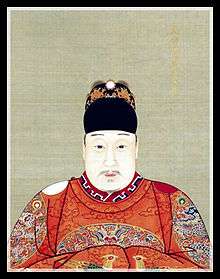 Shenzong 神宗 Wanli 萬曆 1572–1620 | Zhu Yiliu 朱翊镠 1568-1614 Prince of Lu | Zhū Yiju 朱翊鉅 ?-1616 Prince of Huai 淮王 | Zhu Shouyong 朱壽鏞 ?-1639 Prince Su of Lu 魯肅王 | Zhu Yujian 朱聿鍵 1602–1646  Prince of Tang 唐王 Longwu 隆武 1645–1646 | Zhu Yuyue 朱聿𨮁 1605–1646 Prince of Tang 唐王 Shaowu 紹武 1646 | ||||||||||||||||||||||||||||||||||||||||||||||||||||||||
| 1 | 3 | 7 | 3 | 5 | |||||||||||||||||||||||||||||||||||||||||||||||||||||||||
| Zhu Changluo 朱常洛 1582–1620  Guangzong 光宗 Taichang 泰昌 1620 | Zhu Changxun 朱常洵 1586–1641 Prince Zhong of Fu 福忠王 | Zhu Changying 朱常瀛 1601–1645 Prince Duan of Gui 桂端王 | Zhu Changfang 朱常淓 1608–1646 Prince of Lu 潞王 | Zhu Changqing 朱常清 d.1649 Prince of Huai Dongwu 東武 1648-1649 | Zhu Yihai 朱以海 1618–1662 Gengyin 1645-1655 | Zheng Chenggong 鄭成功 1624-1662 Koxinga 國姓爺 Ruler of the Tungning 1661–1662 | |||||||||||||||||||||||||||||||||||||||||||||||||||||||
| 1 | 5 | 8 | 4 | ||||||||||||||||||||||||||||||||||||||||||||||||||||||||||
| Zhu Youxiao 朱由校 1605–1627  Xizong 熹宗 Tianqi 天啟 1620–1627 | Zhu Youjian 朱由檢 1611–1644 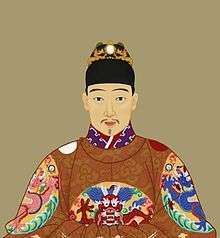 Sizong 思宗 Chongzhen 崇禎 1627–1644 | Zhu Yousong 朱由崧 1607–1646 Prince of Fu 福王 Hongguang 弘光 1644–1645 | Zhu Youlang 朱由榔 1623–1662 Prince of Gui 桂王 Yongli 永曆 1646–1662 | Zhu Honghuan 朱弘桓 | Zhèng Shì 鄭氏 | ||||||||||||||||||||||||||||||||||||||||||||||||||||||||
Qing dynasty
The following is a simplified family tree for the Qing dynasty, which ruled China between 1644 and the declaration of the Republic of China on January 1, 1912.
Those who became emperor of China are listed in bold, with their years of reign. Nurhaci and Hong Taiji were emperors of the dynasty, which at the time dominated the Manchuria region, but were not emperors of China as a whole; their years of reign over the dynasty are therefore given in brackets. The names given for emperors are era names, the form by which Qing emperors were most commonly known (with the exception of Puyi, who ruled as the Xuantong Emperor, but was generally known by his given name after his deposition). Puyi abdicated as head of state on February 12, 1912, but was permitted to retain his imperial titles until 1924. The imperial family's original Manchu clan name was Aisin Gioro (lit. "golden clan"). The dynasty was originally titled the Later Jin dynasty, in reference to its origins in the Jurchen-led Jin dynasty (1115–1234), by Nurhaci in 1616, but in 1636 Hong Taiji opted to replace this title with the Chinese dynastic title Qing (清), meaning "clear" or "pure".
- - Qing dynasty emperors
- - 1st generation of Iron Cap Princes
- – – – - The dashed lines denotes the adoptions
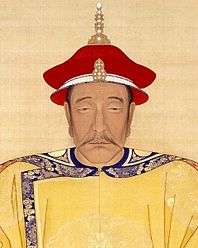



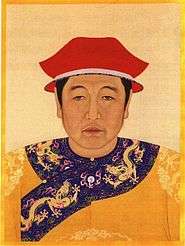
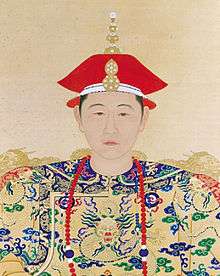




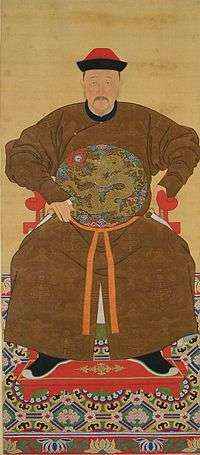
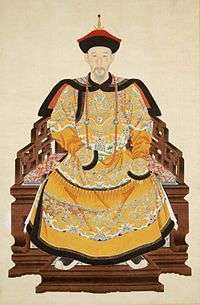


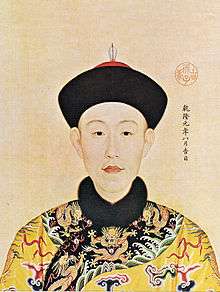



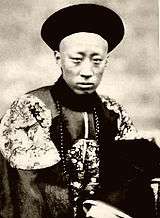


.jpg)

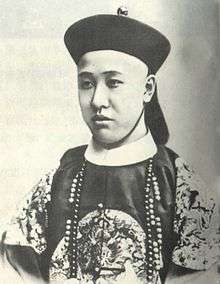


.jpg)